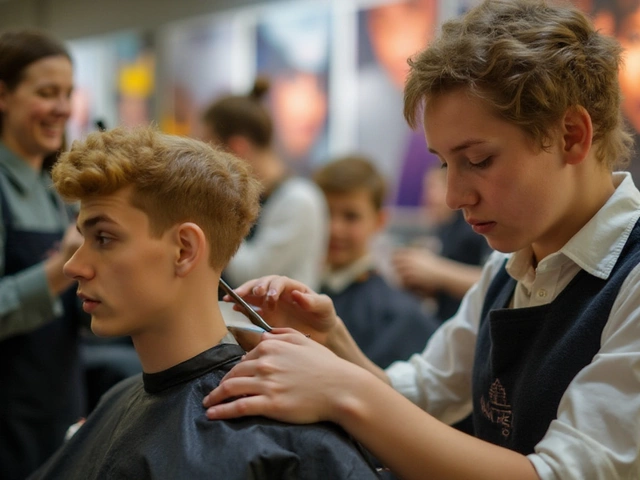If you can learn guitar off YouTube, can you cut hair the same way? Loads of people try to become self-taught hairdressers and save cash on courses by watching online tutorials or practicing on friends. The idea sounds simple, but hair—unlike a misshapen cake or a botched drawing—won't just grow back overnight. Mess it up, and everyone notices (ask me how I know; Charlie refused to pose for selfies for a week after my scissor experiment).
Let's cut the fluff: You need more than just a good pair of scissors and some boldness. Hairdressing is about sharp technique, knowing what works for different hair types, and having the guts to fix a mistake. You need to learn how to handle clippers, scissors, and maybe even color, all without burning someone's scalp or turning someone's bangs into instant regret. But is it doable without a classroom or license? Tons of folks start by teaching themselves at home. Let's get into how far you can go solo and where you might hit a wall.
- What You Really Need to Learn
- Best Ways to Teach Yourself Hairdressing
- When to Consider Professional Training
- Tips, Must-Haves, and Real-World Challenges
What You Really Need to Learn
Deciding to become a self taught hairdresser is more than just figuring out how to avoid bad haircuts. There’s an actual skill list you can’t skip if you want anyone to trust you with their head. The basics aren’t just about chopping off split ends or trimming a beard. Here’s what pros agree you really need to nail:
- How hair grows and types: Straight hair acts nothing like curly or kinky hair. There’s a reason hairdressers obsess over hair texture and growth patterns. Knowing this lets you pick the right tools and avoid rookie mistakes, like turning curls into frizz with the wrong drying technique.
- Sanitation: You can’t just wipe scissors on your tee and call it good. Clean tools = safe clients. Licensing tests are obsessed with this for a reason: dirty tools can spread ringworm, lice, or worse. Keep some Barbicide and rubbing alcohol in your kit at all times.
- Sectioning and cutting methods: Layering, point cutting, and basic trims all need solid sectioning. If you don’t section properly, the haircut will be uneven or, worse, obviously DIY.
- Blending and fading: Whether it’s a men’s fade or a long bob, blending is what separates a good cut from a backyard disaster. If you skip practice here, your results will show weird lines and steps—not cute.
- Using clippers and scissors: Clippers need the right guards for fades and buzzes. Scissors (shears, really) vary in size and purpose. Invest in ones meant for hair—not your kitchen.
- Product basics: Mousse, gel, creams, and heat protectants change results fast. Knowing which to use—and when—can literally save a cut from looking amateurish.
Even the best YouTube teachers will tell you: mastering these basics takes time, not just watching one video and going for it. Here’s what Ruth Roche, a six-time NAHA-winning educator, says:
“The fundamentals—like sectioning, elevation, finger angle—are what let you create great haircuts. Without those, you’re only guessing.”
Many wannabe stylists think color is a good area to self-teach, but mistakes here can fry hair or cause allergic reactions. About 37% of home color jobs end up needing a pro fix, according to a UK-based hairdressing survey. As tempting as it is, stick to natural hues and do patch tests if you go there at all.
Here’s a fast tip list to know you’re on the right track before offering to cut anyone’s hair:
- Can you explain the difference between point cutting and blunt cutting?
- Do you know the safe way to disinfect your tools?
- Are you comfortable sectioning hair cleanly and evenly?
- Can you blend a fade without leaving steps or lines?
- Do you know what style suits which face shape?
If you can tick those off, you’re way ahead of most self-taught beginners. Before you offer yourself up as the next hairdressing genius, make sure the basics are second nature—not just luck of the draw.
Best Ways to Teach Yourself Hairdressing
First thing’s first: forget the idea that you’ll pick up every skill overnight. Learning to be a self taught hairdresser actually means practicing the basics a lot, making mistakes, and being cool with slow progress. But it’s not just about randomly hacking away at hair. Here’s what works when you’re learning on your own.
- Watch High-Quality Tutorials: Sites like YouTube aren’t just full of cat videos—there are pro hairdressers showing real techniques, step by step. Look for videos with lots of likes and clear, close-up shots. Some creators, like Sam Villa or Brad Mondo, break down why you do each move, not just how.
- Practice on Mannequin Heads: You can get a decent mannequin head for $30-50 online. Practicing on fake hair means you can try fades, layers, or curls with zero risk to anyone’s image (or self-esteem). If it looks awful, just try again. That’s why beauty schools still use mannequins for basics.
- Start with Simple Styles: Focus on stuff like one-length cuts, basic layers, or clean tapers before getting fancy. Doing these over and over gets your hands steady and your eyes trained for mistakes. Trying to nail a complex bob too soon is a recipe for heartbreak (for you or your friend).
- Use Forums and Social Groups: Places like Reddit’s r/hairdressing or Facebook groups can be goldmines for feedback and advice. Post a pic, ask how you can improve—it’s like having a bunch of teachers in your pocket.
- Read Up and Take Notes: There are hairdressing books that explain stuff tutorials skip, like why you section hair a certain way, or how cutting angles change a look. "Milady Standard Cosmetology" is one of the classics for a reason.
- Record Yourself: Watching yourself cut hair helps spot what you’re doing wrong—wonky hand angles show up clearly on video. Your phone can be your best (and harshest) teacher.
If you want some hard data, check this:
| Learning Resource | Avg. Cost | Success Rate* |
|---|---|---|
| YouTube & Free Online Tutorials | $0 | Good for basics, but mixed long-term results |
| Mannequin Head Practice Kits | $30–$100 | Massive skill jump for hands-on people |
| Books | $20–$80 | Helps nail theory—best with hands-on work |
*Based on user feedback in major hairdressing forums (as of 2024)
The point is, to really become a self taught hairdresser, mix online learning with hands-on trial and error. Don’t skip the "fail and try again" part—that’s where the real magic happens, even if your dog runs for cover at first.

When to Consider Professional Training
There comes a point when cutting hair at home hits a ceiling. Sure, you can pick up the basics—like trimming ends, blending fades, and even doing some simple coloring. But if you want to become a full-on self taught hairdresser who takes on clients or even dreams of working in a salon, you’ll run into things you just can’t Google your way out of.
First off, safety is a big deal. Hair dyes and chemicals can cause burns, allergic reactions, or even serious injuries if you don’t know what you’re doing. Salons teach you to mix and apply color safely. Plus, things like scalp conditions, infections, and allergies aren’t always obvious. Training helps you spot these problems and avoid mistakes that could hurt someone or get you in legal trouble.
Then there’s precision. Basic cuts are doable at home, but for advanced styles, sharp lines, and techniques like layering, you typically need hands-on feedback from a pro. Training courses let you practice on different hair types and see where you might mess up before it matters.
Let’s talk about the legal side. Most places require you to have a license to work professionally. That usually means clocking a certain number of classroom hours or apprenticeships, and passing an exam covering everything from cuts to sanitation rules. Without it, you can’t legally work in a salon, and you might have trouble getting insurance if you’re freelancing. Check local laws—don’t just assume you’re covered because you’ve seen every tutorial online.
| Area | At-Home Learning | Professional Training |
|---|---|---|
| Basic Cuts | Possible | Refined and improved |
| Chemical Treatments | Risky | Step-by-step safe training |
| Licensing | Not available | Required |
| Client Safety & Hygiene | Often missed | Core focus |
If you hit a wall with self-education or want to take paid clients, look for a local hairdressing course. Try workshops, part-time programs, or official apprenticeships. Many people who started as self taught hairdressers end up enrolling to pass licensing exams or just level up their skills. Think of it as backing up your natural talent with solid, real-world experience—and making yourself legit.
Tips, Must-Haves, and Real-World Challenges
Going the self taught hairdresser route means you’re your own teacher, critic, and fixer. There’s nothing stopping you from grabbing scissors and having a go at it, but you’ll want to stack the odds in your favor. Let’s get into straightforward tips that’ll save you from rookie mistakes and maybe even a few disasters.
First, don’t cheap out on your tools. There’s a huge difference between actual hairdressing scissors and kitchen scissors (trust me, your edges will suffer). Go for stainless steel shears, thinning scissors, a set of reliable clippers, and at least two combs with different tooth spacing. Here’s what a basic kit could cost in 2025:
| Tool | Average Price (USD) |
|---|---|
| Professional Scissors | $50–120 |
| Thinning Shears | $25–70 |
| Clippers | $40–150 |
| Combs (2+) | $10–20 |
| Capes/Aprons | $10–30 |
| Mannequin Head (for practice) | $30–60 |
As a self taught hairdresser, practice will be your best friend. Mannequin heads are a lifesaver here; you can mess up, learn, and try again, which is way less stressful than experimenting on a person. Record yourself or use a mirror from different angles, so you catch what you’re actually doing with your hands and tools. Try to follow along with quality online tutorials—don’t just watch, actually pause and do each step until it’s muscle memory.
Keep these tips in mind:
- Work with clean, damp—but not soaking wet—hair for better control.
- Section hair properly before you start. Clips are essential.
- Invest in a spray bottle to keep hair damp as you work.
- Start slow. Take less off than you think. You can always snip more, never less.
- Be picky about your lighting—bad light hides mistakes until it’s too late.
Let’s talk real-world stuff. Clients (even friends and family) will compare your work with the pros. If you mess up a cut, be ready to own it and offer to fix it. And hair color? Honestly, unless you’re cool with mistakes showing for weeks, you may want to leave serious coloring to the pros or take a coloring-only course before going wild.
Another challenge—working without feedback. A self taught hairdresser can get caught in bad habits. Share your work online or with a local stylist and actually listen to their criticism. Fixing a habit early saves you pain later.
Pro tip: If you’re hoping to make money or even start a gig as a hairdresser for others, check your local rules. Lots of cities require a hairdressing license for paid services, even if you learned at home. You don’t want a fine shutting down your budding business before you get rolling.





Write a comment